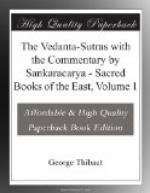Here an objection may be raised. How, it is asked, can we speak of the true nature (svarupa) of that which is unchanging and eternal, and then say that ‘it appears in its own form (true nature)?’ Of gold and similar substances, whose true nature becomes hidden, and whose specific qualities are rendered non-apparent by their contact with some other substance, it may be said that their true nature is rendered manifest when they are cleaned by the application of some acid substance; so it may be said, likewise, that the stars, whose light is during daytime overpowered (by the superior brilliancy of the sun), become manifest in their true nature at night when the overpowering (sun) has departed. But it is impossible to speak of an analogous overpowering of the eternal light of intelligence by whatever agency, since, like ether, it is free from all contact, and since, moreover, such an assumption would be contradicted by what we actually observe. For the (energies of) seeing, hearing, noticing, cognising constitute the character of the individual soul, and that character is observed to exist in full perfection, even in the case of that individual soul which has not yet risen beyond the body. Every individual soul carries on the course of its practical existence by means of the activities of seeing, hearing, cognising; otherwise no practical existence at all would be possible. If, on the other hand, that character would realise itself in the case of that soul only which has risen above the body, the entire aggregate of practical existence, as it actually presents itself prior to the soul’s rising, would thereby be contradicted. We therefore ask: Wherein consists that (alleged) rising from the body? Wherein consists that appearing (of the soul) in its own form?




